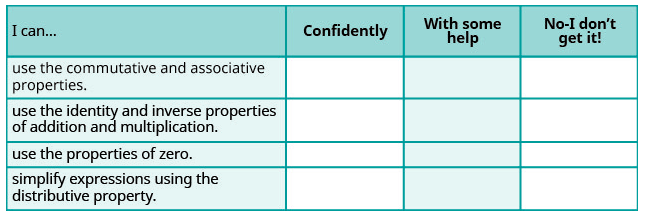1.10E: Exercises
( \newcommand{\kernel}{\mathrm{null}\,}\)
Practice Makes Perfect
Use the Commutative and Associative Properties
In the following exercises, use the associative property to simplify.
3(4x)
- Answer
-
12x
4(7m)
(y+12)+28
- Answer
-
y+40
(n+17)+33
In the following exercises, simplify.
12+78+(−12)
- Answer
-
78
25+512+(−25)
320⋅4911⋅203
- Answer
-
4911
1318⋅257⋅1813
−24⋅7⋅38
- Answer
-
−63
−36⋅11⋅49
(56+815)+715
- Answer
-
156
(1112+49)+59
17(0.25)(4)
- Answer
-
17
36(0.2)(5)
[2.48(12)](0.5)
- Answer
-
14.88
[9.731(4)](0.75)
7(4a)
- Answer
-
28a
9(8w)
−15(5m)
- Answer
-
−75m
−23(2n)
12(56p)
- Answer
-
10p
20(35q)
43m+(−12n)+(−16m)+(−9n)
- Answer
-
27m+(−21n)
−22p+17q+(−35p)+(−27q)
38g+112h+78g+512h
- Answer
-
54g+12h
56a+310b+16a+910b
6.8p+9.14q+(−4.37p)+(−0.88q)
- Answer
-
2.43p+8.26q
9.6m+7.22n+(−2.19m)+(−0.65n)
Use the Identity and Inverse Properties of Addition and Multiplication
In the following exercises, find the additive inverse of each number
- 25
- 4.3
- −8
- −103
- Answer
-
- −25
- −4.3
- 8
- 103
- 59
- 2.1
- −3
- −95
- −76
- −0.075
- 23
- 14
- Answer
-
- 76
- 0.075
- −23
- −14
- −83
- −0.019
- 52
- 56
In the following exercises, find the multiplicative inverse of each number.
- 6
- −34
- 0.7
- Answer
-
- 16
- −43
- 107
- 12
- −92
- 0.13
- 1112
- −1.1
- −4
- Answer
-
- 1211
- −1011
- −14
- 1720
- −1.5
- −3
Use the Properties of Zero
In the following exercises, simplify.
06
- Answer
-
0
30
0÷1112
- Answer
-
0
03
60
- Answer
-
undefined
0⋅815
(−3.14)(0)
- Answer
-
0
1100
Mixed Practice
In the following exercises, simplify.
19a+44−19a
- Answer
-
44
27c+16−27c
10(0.1d)
- Answer
-
1d
100(0.01p)
0u−4.99, where u≠4.99
- Answer
-
0
0v−65.1, where v≠65.1
0÷(x−12), where x≠12
- Answer
-
0
0÷(y−16), where y≠16
32−5a0, where 32−5a≠0
- Answer
-
undefined
28−9b0, where 28−9b≠0
(34+910m)÷0 where 34+910m≠0
- Answer
-
undefined
(516n−37)÷0 where 516n−37≠0
15⋅35(4d+10)
- Answer
-
36d+90
18⋅56(15h+24)
Simplify Expressions Using the Distributive Property
In the following exercises, simplify using the distributive property.
8(4y+9)
- Answer
-
32y+72
9(3w+7)
6(c−13)
- Answer
-
6c−78
7(y−13)
14(3q+12)
- Answer
-
34q+3
15(4m+20)
9(59y−13)
- Answer
-
5y−3
10(310x−25)
12(14+23r)
- Answer
-
3+8r
12(16+34s)
r(s−18)
- Answer
-
rs−18r
u(v−10)
(y+4)p
- Answer
-
yp+4p
(a+7)x
−7(4p+1)
- Answer
-
−28p−7
−9(9a+4)
−3(x−6)
- Answer
-
−3x+18
−4(q−7)
−(3x−7)
- Answer
-
−3x+7
−(5p−4)
16−3(y+8)
- Answer
-
−3y−8
18−4(x+2)
4−11(3c−2)
- Answer
-
−33c+26
9−6(7n−5)
22−(a+3)
- Answer
-
−a+19
8−(r−7)
(5m−3)−(m+7)
- Answer
-
4m−10
(4y−1)−(y−2)
5(2n+9)+12(n−3)
- Answer
-
22n+9
9(5u+8)+2(u−6)
9(8x−3)−(−2)
- Answer
-
72x−25
4(6x−1)−(−8)
14(c−1)−8(c−6)
- Answer
-
6c+34
11(n−7)−5(n−1)
6(7y+8)−(30y−15)
- Answer
-
12y+63
7(3n+9)−(4n−13)
Everyday Math
Insurance copayment Carrie had to have 5 fillings done. Each filling cost $80. Her dental insurance required her to pay 20% of the cost as a copay. Calculate Carrie’s copay:
- First, by multiplying 0.20 by 80 to find her copay for each filling and then multiplying your answer by 5 to find her total copay for 5 fillings.
- Next, by multiplying [5(0.20)](80)
- Which of the properties of real numbers says that your answers to parts (a), where you multiplied 5[(0.20)(80)] and (b), where you multiplied [5(0.20)](80), should be equal?
- Answer
-
- $80
- $80
- answers will vary
Cooking time Helen bought a 24-pound turkey for her family’s Thanksgiving dinner and wants to know what time to put the turkey in to the oven. She wants to allow 20 minutes per pound cooking time. Calculate the length of time needed to roast the turkey:
- First, by multiplying 24·20 to find the total number of minutes and then multiplying the answer by 160 to convert minutes into hours.
- Next, by multiplying 24(20⋅160).
- Which of the properties of real numbers says that your answers to parts (a), where you multiplied (24⋅20)160, and (b), where you multiplied 24(20⋅160), should be equal?
Buying by the case Trader Joe’s grocery stores sold a bottle of wine they called “Two Buck Chuck” for $1.99. They sold a case of 12 bottles for $23.88. To find the cost of 12 bottles at $1.99, notice that 1.99 is 2−0.01.
- Multiply 12(1.99) by using the distributive property to multiply 12(2−0.01).
- Was it a bargain to buy “Two Buck Chuck” by the case?
- Answer
-
- $23.88
- no, the price is the same
Multi-pack purchase Adele’s shampoo sells for $3.99 per bottle at the grocery store. At the warehouse store, the same shampoo is sold as a 3 pack for $10.49. To find the cost of 3 bottles at $3.99, notice that 3.99 is 4−0.01.
- Multiply 3(3.99) by using the distributive property to multiply 3(4−0.01).
- How much would Adele save by buying 3 bottles at the warehouse store instead of at the grocery store?
Writing Exercises
In your own words, state the commutative property of addition.
- Answer
-
Answersmayvary
What is the difference between the additive inverse and the multiplicative inverse of a number?
Simplify 8(x−14) using the distributive property and explain each step.
- Answer
-
Answersmayvary
Explain how you can multiply 4($5.97) without paper or calculator by thinking of $5.97 as 6−0.03 and then using the distributive property.
Self Check
ⓐ After completing the exercises, use this checklist to evaluate your mastery of the objectives of this section.

ⓑ After reviewing this checklist, what will you do to become confident for all objectives?


